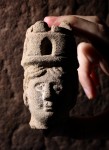 A volunteer with WallQuest, a community archaeology project excavating Arbeia Roman fort in South Shields at the easternmost end of Hadrian’s Wall has discovered a carved stone head of a goddess. The small figure is just over three inches high and is finely carved. She wears a mural crown — a crown in the shape of battlements — that identifies her as a protective goddess. Archaeologists believe she is a representation of Brigantia, the goddess of the northern British tribe of the Brigantes. Indeed, an altar inscribed “Deae Brigantiae sacrum Congenncus (V[otum] S[olvit] L[ibens] M[erito]” (To the sacred goddess Brigantia Congenncus willingly and deservedly fulfilled his vow) was unearthed 100 yards from the head in 1895, and at least one other statue of Brigantia wearing a mural crown has been found.
A volunteer with WallQuest, a community archaeology project excavating Arbeia Roman fort in South Shields at the easternmost end of Hadrian’s Wall has discovered a carved stone head of a goddess. The small figure is just over three inches high and is finely carved. She wears a mural crown — a crown in the shape of battlements — that identifies her as a protective goddess. Archaeologists believe she is a representation of Brigantia, the goddess of the northern British tribe of the Brigantes. Indeed, an altar inscribed “Deae Brigantiae sacrum Congenncus (V[otum] S[olvit] L[ibens] M[erito]” (To the sacred goddess Brigantia Congenncus willingly and deservedly fulfilled his vow) was unearthed 100 yards from the head in 1895, and at least one other statue of Brigantia wearing a mural crown has been found.
The find is a small, finely carved female head which is believed to date back to the second century AD and stands at 8cm high. Every part is delicately carved including eyes, nose, mouth and hairstyle with traces of pink paint on the statues face as well as a bit of red on her lips.
 The head dates to the 2nd century A.D., early in the life of the fort which was first built overlooking the River Tyne around 160 A.D. and enlarged in 208 A.D. to serve as a maritime supply base the soldiers along Hadrian’s Wall. We know the stone goddess predates that expansion because it was found in an aqueduct channel that was filled so new construction could be done on top of it. The statue of the goddess wouldn’t have been freestanding on its own; given the discovery of her head and the altar found in the 19th century, it’s likely that there was a shrine to Brigantia in Arbeia that was demolished to make room for the enlargement of the fort.
The head dates to the 2nd century A.D., early in the life of the fort which was first built overlooking the River Tyne around 160 A.D. and enlarged in 208 A.D. to serve as a maritime supply base the soldiers along Hadrian’s Wall. We know the stone goddess predates that expansion because it was found in an aqueduct channel that was filled so new construction could be done on top of it. The statue of the goddess wouldn’t have been freestanding on its own; given the discovery of her head and the altar found in the 19th century, it’s likely that there was a shrine to Brigantia in Arbeia that was demolished to make room for the enlargement of the fort.
 Troop divisions at Arbeia that have been identified thus far include boatmen from the Tigris River in what was then Persia, now Iraq, Gaulish infantry, Spanish cavalry (First Asturian) and Syrian archers. Although locals probably enlisted later on, when the statue was standing, it was these units from all over the empire who were likely responsible for creating the shrine to the local goddess.
Troop divisions at Arbeia that have been identified thus far include boatmen from the Tigris River in what was then Persia, now Iraq, Gaulish infantry, Spanish cavalry (First Asturian) and Syrian archers. Although locals probably enlisted later on, when the statue was standing, it was these units from all over the empire who were likely responsible for creating the shrine to the local goddess.
Nick Hodgson, WallQuest Project Manager, said:
“The head is a truly wonderful find. Northern Britain was a dangerous place for the Roman army in the second century AD; if the goddess is Brigantia it shows how keen the Romans were to placate the spirits of the region.”
 It must have worked, because Arbeia and the civilian settlement that grew in its shadow remained in active use for decades after most of the other fort settlements on Hadrian’s Wall were abandoned or greatly contracted. There was new construction in the Arbeia settlement in the late 3rd century or early 4th. This is attributable to its commercial importance as a maritime fort and market center. The only permanent masonry granaries ever found in Britain were built in Arbeia. The fort and settlement were in use through the end of the Roman occupation in the 5th century.
It must have worked, because Arbeia and the civilian settlement that grew in its shadow remained in active use for decades after most of the other fort settlements on Hadrian’s Wall were abandoned or greatly contracted. There was new construction in the Arbeia settlement in the late 3rd century or early 4th. This is attributable to its commercial importance as a maritime fort and market center. The only permanent masonry granaries ever found in Britain were built in Arbeia. The fort and settlement were in use through the end of the Roman occupation in the 5th century.
The head of Brigantia will be conserved over the next few months. In Spring of 2015, it will go on display at the Arbeia Roman Fort & Museum. At the same time the community excavation project at Arbeia will begin again, and volunteers will have the opportunity to look for the rest of the statue.